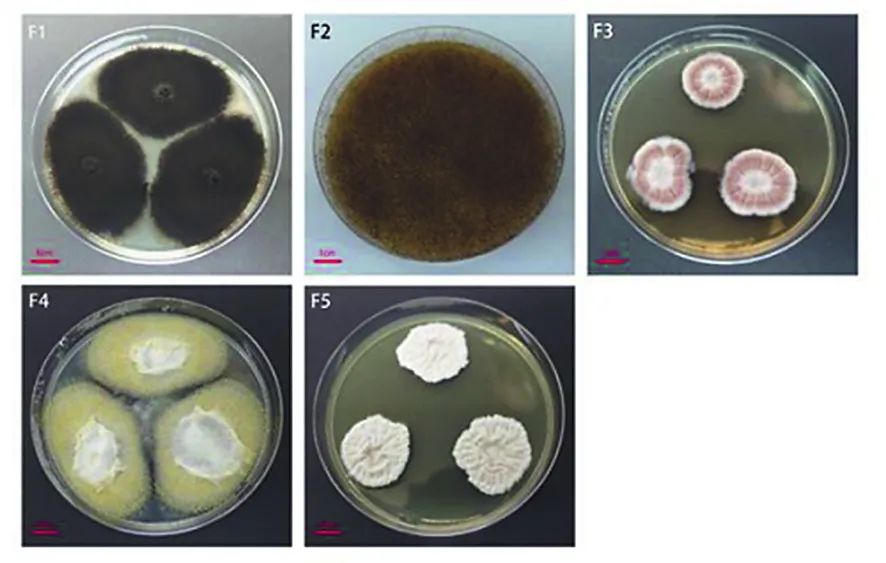The shell is beautiful!When you are unfortunately a "mold" melon seed ...
Author:Journal of China Science Time:2022.08.10
Text | "China Science News" trainee reporter Wang Min

The fungal colonies are separated from the inner sunflower seeds: F1 is chain groma (advantageous bacteria); F2 is root mold; F3 is Safeng mold; F4 is yellow mold; F5 is white mold. Figures of the research group
Sunflower seeds are common leisure snacks in life. Suddenly eating a "mold" melon seeds when you sip the melon seeds, which is a discomfort experience that many people have experienced. Have you ever wondered why the shell is obviously moldy? How to prevent mold?
Recently, Wu Yuejin, a researcher at the Institute of Intelligent Machinery Research Institute of Hefei Material Sciences at the Academy of Sciences of the Chinese Academy of Sciences, first revealed the mechanism of the internal mold changes inside the sunflower seeds, and proposed the control measures to control the growth of mold and spread the food chain. The research and prevention and control of the internal mildew mechanism of nuts provides important model references. Related results were published in "Microorganisms".
Hidden mold
Sunflower seeds are rich in unsaturated fatty acids, proteins, multiple vitamins and trace elements, and are usually eaten or used to extract edible oil. China is the fourth largest sunflower seed producer in the world after Ukraine, Russia and Argentina.
"Most of the shells of the inner moldy sunflower seeds are normal, and it is difficult to identify by the naked eye or color selection equipment, which causes consumers to eat it by mistake, affect the consumption experience of food, and endanger human health." Introduce the China Science News that the internal mold changes inside the sunflower seeds are a problem facing production and consumption.
In fact, in recent decades, the mildew risk of agricultural products, especially grain crops, has attracted global attention. However, the research on oil seeds represented by sunflower seeds is significantly lagging behind grain crops.
Liu Binmei believes: "Finding out how the inner mold in the sunflower seeds occurs is the basis of detection and prevention and control. At present, research at home and abroad is basically blank, so this work seems particularly urgent and important."
It is worth mentioning that the research group has successfully developed the grain quality detection platform, and the non -destructive detection method of the degree of mildew and quality of the nuts such as sunflower seeds is also under development.
So far, previous research only selected sunflower seeds sold on the market as research objects, and these studies often only detect microorganisms carried on their shells or seeds on the surface of the seed kernels and ignore endogenous microorganisms.
The main goal of the scientific research team of the Intelligent Institute is to study the changes between microbial communities in the production cycle of the entire sunflower seeds and the relationship between the internal mold, and explore the possible source of internal mold and important factors, so as to be sunflower seeds Safety production provides technical support.
Inner mold mainly occurs in the field planting period
Inner Mongolia Autonomous Region is China's largest sunflower production area.
From 2018 to 2020, the smart institute team collected a large number of sunflower seed samples that harvested the warehouse and stored in the Sunflower Seed Factory after forming a lot of warehouses.
Subsequently, the team used the high -throughput sequencing technology to accurately express the characteristics of the collected sunflower seed population community, study the relationship between the development of the inner mold and the changes in the structure of the microbial community, and revealing the source and related factors of the inner mold group.
The results of the study show that the fungus of the inner sunflower seed keel (including exogenous and endogenous bacteria) is mainly field fungi. Among them, the goger bacteria are the "advantage" of the "advantage" that causes the mold in the sunflower seeds to cause mold.
The inner mold in the sunflower seeds mainly occurs in the field planting period. Liu Jie, the first author of the dissertation and a doctoral student of the Institute of Intelligent, explained: "Usually, the seeds will be infected by chains in the development stage, and the humid conditions in the field provide favorable conditions for their reproduction. Inner mold. "
The study also found that the sunflower seeds were stored below the safety threshold for more than 6 months, and the microorganism community structure has hardly changed, and the seed kernels maintain a normal appearance. However, when the temperature and humidity conditions exceed the safety threshold, with the changes of the microbial community structure, the seed kernels begin to occur, and the degree of mildew is increasing with the increase in environmental humidity and storage fungal abundance.
Proper field management is the primary direction
How to effectively prevent and control the inner mold of sunflower seeds? Liu Binmei believes that because the internal mold changes mainly occur in the field planting stage, the field management of chain groma bacteria is the primary direction.
In addition, although the inner mold in the main producing area of sunflower seeds is dominated by the planting period in the field, it should also prevent the occurrence of fungi related to storage. As the short -term exposure to high humidity environment, it will quickly increase the growth of mold in the sunflower seeds, so the environmental dehumidification will be essential.
"The preliminary research results of physical prevention and control show that for non -main producing seeds with large water content or relatively high humidity, physical radiation treatment methods such as γ -ray irrades before storage can effectively reduce or prevent the occurrence of internal mold. "Liu Jie said.
Understanding the reason why the mildew in the sunflower seeds is the first step. Next, the team will study how to effectively prevent and control and detect the inner mold, such as changing cultivation methods, developing new pharmaceuticals, cultivating resistance varieties, and developing biological spectrum lossless detection technology.
For this study, the reviewer believes that it "has important theoretical significance and practical significance and has made positive contributions to related research areas."
Related thesis information:
https://doi.org/10.3390/microorganisms10071434
"China Science News" (2022-08-10 3rd Edition)
Edit | Zhao Lu
typesetting | Zhihai

- END -
1 case of new local diagnosis in Jiangsu, 4 cases of new native symptoms without infection

At 0-24 on August 18th, 1 new local diagnosis case in Jiangsu (Nanjing report, whi...
[Latest] These 12 areas of Shanghai are classified as the epidemic risk zone
The Office of the Leading Group for the Prevention and Control Work of the New Crown Pneumonic Pneumonia Epidemic Event: According to the requirements of the New Coronatte Virus Pneumonia Prevention